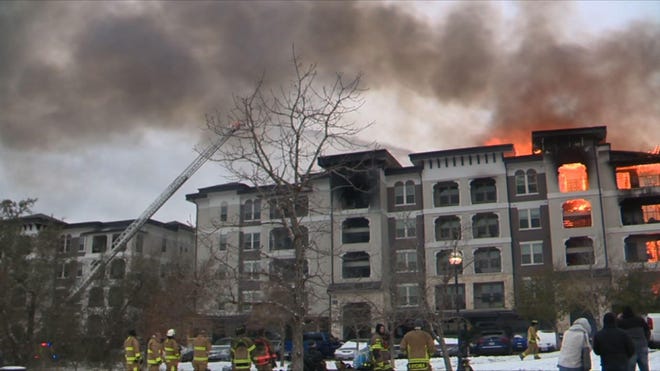Unseasonably winter weather returned this week to the normally arid Permian Basin region as Carlsbad awoke to snowfall and temperatures in the low 30s.
A hazardous weather outlook from the National Weather Service predicted up to an inch and a half of snow could accumulate in portions of Eddy and Lea counties Monday morning.
Wintery conditions were also anticipated in West Texas, per the National Weather Service, but were expected to subside by Tuesday which was forecast to have a high of 62 degrees Fahrenheit and a low of 30.
More:Bills transitioning New Mexico away from oil and gas advance in the Senate, House
The rest of the week was expected to be sunny with highs in the upper 60s to low 70s and lows in the 40s with a 20 percent change of rain on Thursday.
“Light snow will occur across portions of Southeast New Mexico and the Northwest Permian Basin during the morning and early afternoon today,” read Monday’s outlook. “The probability for widespread hazardous weather is low.”
Pollution brings a cycle of weather disruptions
The last time winter weather struck the Permian Basin, the region was not as fortunate.
More:Permian Basin sees more oil investments, New Mexico rig count remains stagnant
In mid-February, a polar vortex hit several southern states including Texas and eastern New Mexico, leaving millions of people without power and damaging infrastructure throughout the region.
Many struggled without power and plumbing as the electrical grid was compromised when pipes carrying natural gas froze.
Aside from the human cost of the winter storm, environmentalists worried the continual infrastructural burden brought by the frigid conditions could spike air pollution from natural gas facilities which lost transportation capacity when pipelines had to be taken offline.
More:‘Radical’ or bipartisan? Haaland’s Interior Secretary hearing a debate on oil and gas
The Environmental Defense Fund (EDF) reported an uptick in venting and flaring events on the Texas side of the basin for the six days of the recent cold snap, bringing on higher levels of volatile organic compounds and chemicals like benzene being released into the air.
Colin Leyden, a researcher with the EDF based in Texas said the failure made clear that policymakers should take notice of climate change.
He said a “negative feedback loop” can be created when air pollution causes climate change, creating hazardous weather that damages infrastructure and causes more pollution.
More:Frigid weather prompts energy alert in Southeast New Mexico
“Because we were hearing and learning that the entire natural gas system experienced failure from power generation all the way to wellhead, we figured that that led to upset events. Sure enough, we found there was a huge uptick in events,” he said.
“We’re still focused on the human casualties along with this, it’s another sort of casualty of these kinds of events where we lost power, we lost water and yet we gained pollution.”
Leyden pointed to data from the Texas Commission on Environmental Quality said VOC emissions in the Permian in Texas were 35 times the VOC levels recorded in January.
More:New Mexico oil and gas regulators a month away from stricter emissions rules
During the 6-day period of the cold snap, records show a 600 percent increase in benzene released, Leyden said.
The incident should lead to better infrastructure planning, he said, to account for climate change and subsequent extreme weather events.
“The change in climate is driving more extreme weather events. We can’t do planning on infrastructure and infrastructure resiliency the same way,” he said. “We’re going to have to start planning forward and looking at what is coming. In Texas, our leaders have been unwilling to acknowledge the role of climate change.”
More:Millions of acres of lands are leased but unused by oil and gas. How does New Mexico compare?
Could it happen in New Mexico?
What happened in Texas was likely to occur just over the border in southeast New Mexico, environmentalists cautioned, in an area known for heavy oil and gas development in its prolific, western portion of the Permian Basin.
Between Feb. 12 and 19, New Mexico’s Oil Conservation Division (OCD) reported 37 spills of either oil, natural gas or produced water.
The database does not include reports for any increased emissions or flaring not considered accidental spills, but the spill that were reported during the cold snap accounted for almost half of the 85 reported in February as of Friday.
More:Permian Basin oil and gas industry seeks solutions to reduce flaring, air pollution
The OCD reported 173 spills in January.
New Mexico’s regulatory agencies mostly relies on the companies themselves to self-report and incidents.
New Mexico Environment Department spokesperson Maddy Hayden said that the Department monitors for spikes in emissions, and that weather events can lead to emergency emission releases when equipment fails.
But she said the NMED did not notice any events the Department considered emergencies and was not notified by any such incidents by operators.
More:New Mexico tracking, reporting oil and gas pollution via mobile app on iPhone, Android
“Inclement weather can result in emergency releases of emissions when equipment fails or malfunctions,” Hayden said. “We actively monitor oil and gas emissions in the state and we have not recorded emergency releases of emissions or received notification of such releases during this time.”
EDF Directory of Regulatory Affairs Jon Goldstein, whose work focuses on New Mexico, said the state does not yet collect adequate data for a full picture of the problem in the Land of Enchantment.
He said ongoing efforts at both the Energy, Minerals and Natural Resources Department – the OCD’s parent agency – and the New Mexico Environment Department should add requirements for reporting of venting and flaring natural gas and bring an end to routine releases.
More:New Mexico bill would give state more authority on air pollution from oil and gas if passed
“We just don’t have access to that same good data to be able to say with any definitiveness what the cold snap meant for pollution in New Mexico. But I think it’s safe to say it wasn’t good,” Goldstein said,.
“What that highlights is the importance of the regulatory improvements that OCD is in the process of finalizing. That includes improvements to record keeping and data so that we would have access to that information in the future.”
Looking ahead, Goldstein said the widespread failure of natural gas delivery for energy throughout Texas and New Mexico was a sign that the states and nation should focus on a transition away from fossil fuels and toward renewable or “cleaner” forms of energy.
More:New Mexico Democrats continue fight against climate change through legislation
In the meantime, as New Mexico relies heavily on extracted oil and natural gas to fuel its economy and daily life, Goldstein said increased regulations need to be pushed to reduce the effects on climate change.
“Oil and gas is the number one source of greenhouse emissions in the state of new Mexico. That’s very important. There also needs to be economy-wide action,” he said. “There are weird weather patterns and scientists are starting to attribute that to pollution.
“There’s a negative feedback loop that can be created, and that’s why we need things like the methane rules to try and cut the emissions that lead to climate change and lead to health impacts on local communities.”
Adrian Hedden can be reached at 575-618-7631, achedden@currentargus.com or @AdrianHedden on Twitter.







